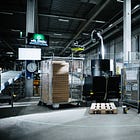How large behavioural models are transforming industrial automation
Insights on the latest developments in the world of autonomous mobile robots.
The world of industrial robots is experiencing its biggest transformation in decades, and it's not just about faster machines or stronger arms. The real breakthrough is happening in how robots learn and think, thanks to what are called Large Behavioural Models (LBMs) - a technology that's making robots smarter and more adaptable than ever before.
Traditional industrial robots have always been like very precise, very expensive puppets. Engineers had to write thousands of lines of code to teach them even simple tasks, and any change in the environment often meant starting from scratch. If one wanted a robot to stack boxes differently or handle a new product shape, one would need weeks of reprogramming by specialists.
Large Behavioural Models flip this script entirely. Think of LBMs as the robot equivalent of ChatGPT - but instead of understanding human language, they understand actions and movements. These AI systems learn by watching thousands of hours of demonstrations, then figure out how to apply that knowledge to new situations they've never seen before.
Just this past week, Boston Dynamics and Toyota Research Institute showcased exactly how game-changing this technology can be. Their Atlas humanoid robot, powered by an LBM, performed a complex sequence of packing and sorting tasks that would have stumped previous generations of robots.
What made this demonstration remarkable wasn't just what Atlas could do, but how it adapted when researchers deliberately interfered - moving boxes, closing lids, and creating obstacles mid-task. The robot simply adjusted and continued working, treating its hands and feet as equally capable tools for solving problems.
This represents a fundamental shift from robots that separate walking from manipulation to machines that use their entire body as one integrated system - much more like how humans approach physical tasks.
The numbers tell the story of this transformation. Toyota Research Institute's research shows that LBMs can learn new skills with 80% less training data than traditional methods. Tasks that once took expert programmers weeks to code can now be taught to robots in an afternoon through simple demonstrations. One LBM can master hundreds of different manipulation tasks and then apply that knowledge to completely new challenges.
This isn't just about making robots more capable - it's about making them practical for businesses that couldn't afford custom automation before. Small manufacturers, warehouses with frequently changing products, and facilities dealing with seasonal demand fluctuations can now deploy robots that adapt rather than require expensive reprogramming.
The warehouse industry is likely to be the first major testing ground, where LBM-powered humanoid robots could work alongside human employees during busy periods without requiring massive infrastructure changes. Unlike traditional automation that demands rebuilding entire workflows, these intelligent machines can drop into existing operations and start contributing immediately.
The robotics industry is moving from an era of rigid automation to one of intelligent collaboration, where teaching a robot a new skill becomes as natural as showing a human colleague how to do a job.



